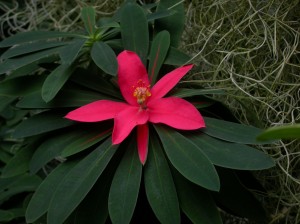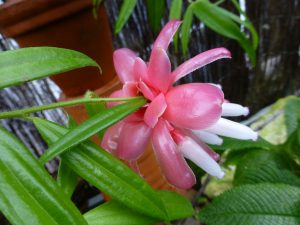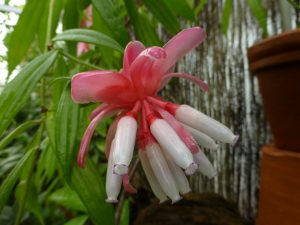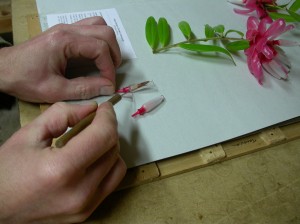This plant was collected in 1976 by one of RBGE’s senior botanists, George Argent, who has now retired but is still working hard collecting and naming plants. It was collected from the lower montane forests of southern Ecuador and he says that it rained continuously for six weeks on his collecting trip which was why all the plants were growing so well! Ecuador is at the top of South America and is so called because it lies on the equator so the day length is the same all year round, 12 hours of day and 12 hours of night. The lowlands and coastal regions of Ecuador experience warm tropical temperatures but higher up in the mountains it can get a lot cooler. This plant has been growing in the tropical glasshouse at Edinburgh which is heated to a minimum temperature of 18°C. It has only flowered three times since 1976 and it has taken us aback with its grace and fine features. The plant has been put in the glass cases in the Tropical Montane House for visitors to see.
The flowers are held at the end of long, fine, woody stems and the leaves are narrow and elegant. The many bright red bracts ensure that it makes more of a show than the flowers would on their own, making it almost look like a double layered flower. The actual flowers are a cluster of small white tubes tipped with purple which lie within the layered bracts. Many plants have bracts around their flowers; bracts are considered to be adapted leaves. Some are large and obvious, sometimes more so than the flower, and others are barely noticeable and green. The red ‘flowers’ of poinsettias (Euphorbia pulcherrima) commonly bought and displayed at Christmas in Britain are actually red bracts surrounding small spurge-like flowers, not petals at all. At RBGE we have a relative of this plant, E. punicea from the Caribbean, which also has this feature. Bracts often serve the function of protecting the buds of the flower, or in the case of this Cavendishia it is possible that the bright red bracts serve to attract hummingbirds or other bird pollinators. Birds are attracted to red colours and if their beaks are fine enough and their tongues long enough they will be rewarded with a drink of sweet nectar found inside the flower.
In 2005 this plant flowered and was given the name Cavendishia aff. bracteata by RBGE botanist, Sabina Knees because it was thought to look like Cavendishia bracteata but was not definitely this species. It turns out that she was right because George has seen these recent flowers and has decided that it is in fact a new species and is not C. bracteata. A herbarium specimen of the stems, leaves, flowers and fruits has been taken so that this new species can be described soon and given its very own name.





1 Comment
1 Pingback